1994 Northridge Earthquake
After the January 17, 1994, magnitude 6.7 Northridge earthquake, surface cracking and other quake-related features were discovered in Potrero Canyon. No problems were reported with the oil wells.

From Rymer and Fumal, 1995 (see sources).
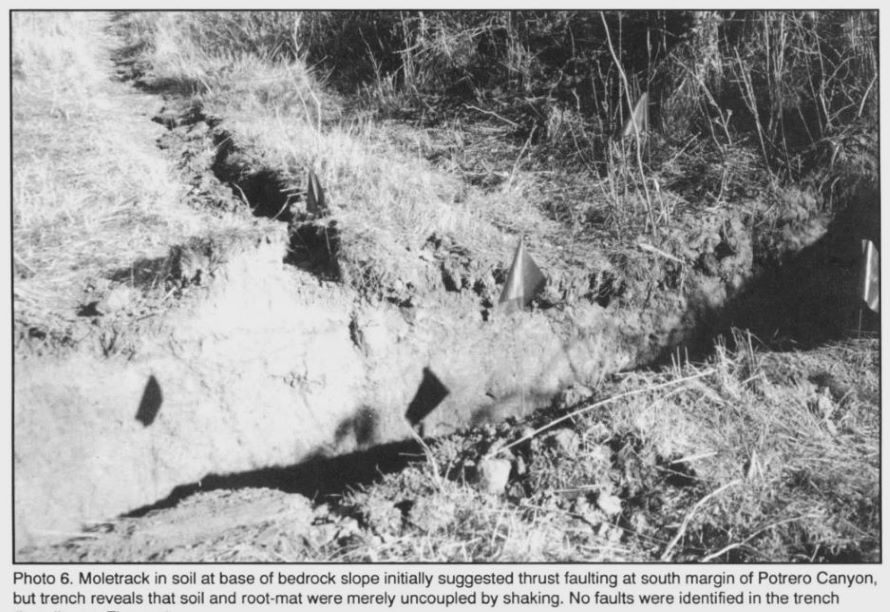
From Rymer and Fumal, 1995.
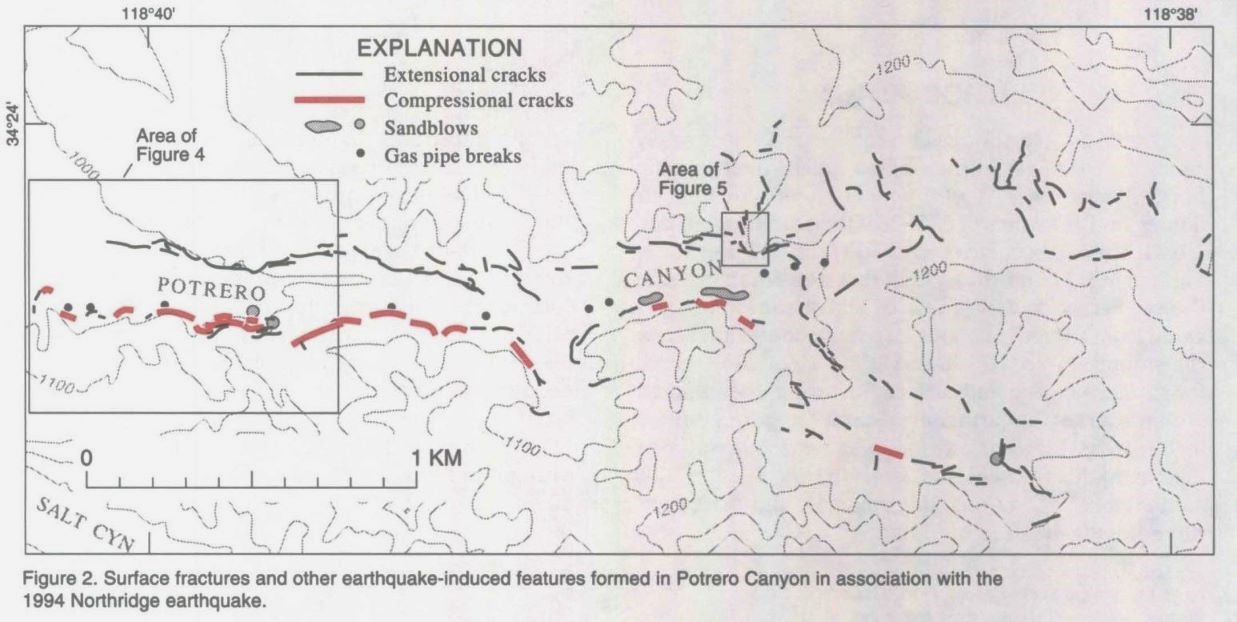
Quake caused features found in Potrero. Rymer and Fumal, 1995.
In the 1994 preliminary report with editors Stewart, Bray, Seed, & Sitar, it is stated that there was:
"Massive liquefaction, ground compaction, and possible tectonic warping of bedrock in Potrero Canyon."
In their US Geological Survey Open-File Report 97-283 (1997, p.3), the authors wrote:
"Potrero Canyon, California, is one of four areas where ground cracks were observed following the 17 January, 1994, Northridge earthquake. The main shock of the Northridge earthquake was generated by a south-dipping blind thrust fault, located approximately 22 km south-southeast of Potrero Canyon. Observations of surface cracks at Potrero are important, because 1) the cracks are located at the approximate surface projection of the blind thrust fault and 2) Potrero Canyon and other parts of the Santa Susana Mountains are currently undergoing rapid suburban growth. If the surface cracks are tectonically related to the Northridge earthquake, the earthquake hazard of the area may be significant."
From the Los Angeles Times, January 22, 1994:
"Dan Ponti and Ken Hudnut, two USGS scientists, said the discovery of a likely rupture zone in Potrero Canyon, north of the Santa Susanas, indicates that a previously undiscovered fault lies in the canyon and that there was ground movement along this fault." "David Schwartz of the USGS, who was there [in Potrero Canyon] Friday, said, 'It's possible this is the tip of the fault that produced the Northridge earthquake.'" "Ponti said that the surface rupture in Potrero Canyon extends about four miles."
From the Modesto Bee, March 7, 1994:
"Did those surface fissures stem from Northridge quake shaking, or from unmapped faults deep beneath the canyon, they wondered. The question was even more intriguing because the canyon lies upward of the Northridge fault. 'If you extrapolate the fault to the surface, it would break here,' said David Schwartz, part of the USGS team from Menlo Park. 'Maybe it's the tip of the fault.'"
Studies needed to be done. Trenches were dug across the surface breaks to study the relationship between the surface cracks and the bedrock. Explosions were set off to gather seismic velocity, reflection, and refraction data from deeper in the ground.
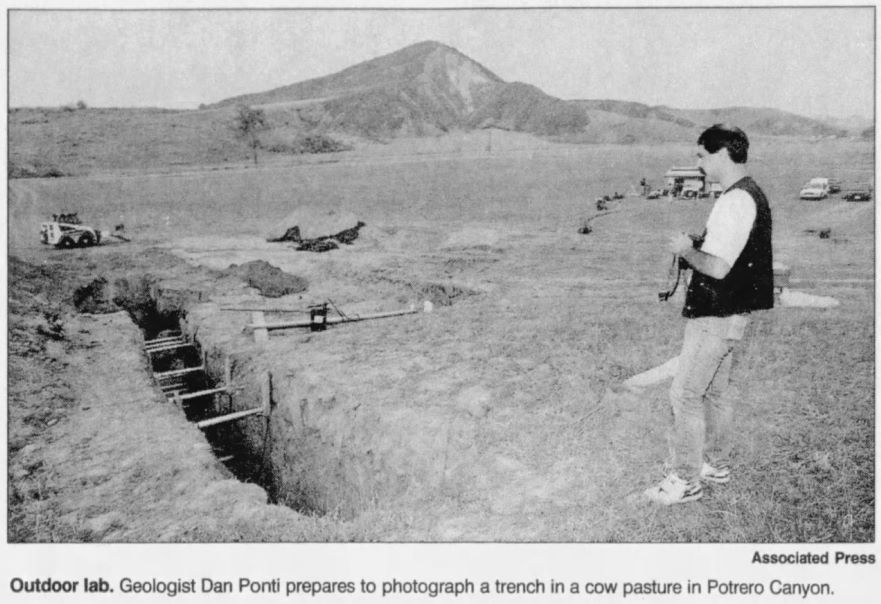
Modesto Bee, March 7, 1994.
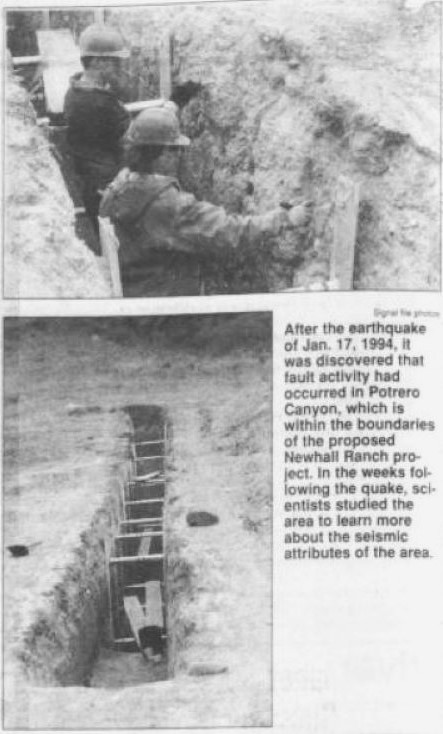
Newhall Signal, August 18, 1998.

Thousand Oaks News Chronicle, May 28, 1994.

Ventura County Star Free Press, March 7, 1994.

Poor quality image from the June 1994 Stewart, Bray, Seed, & Sitar preliminary report (see sources).
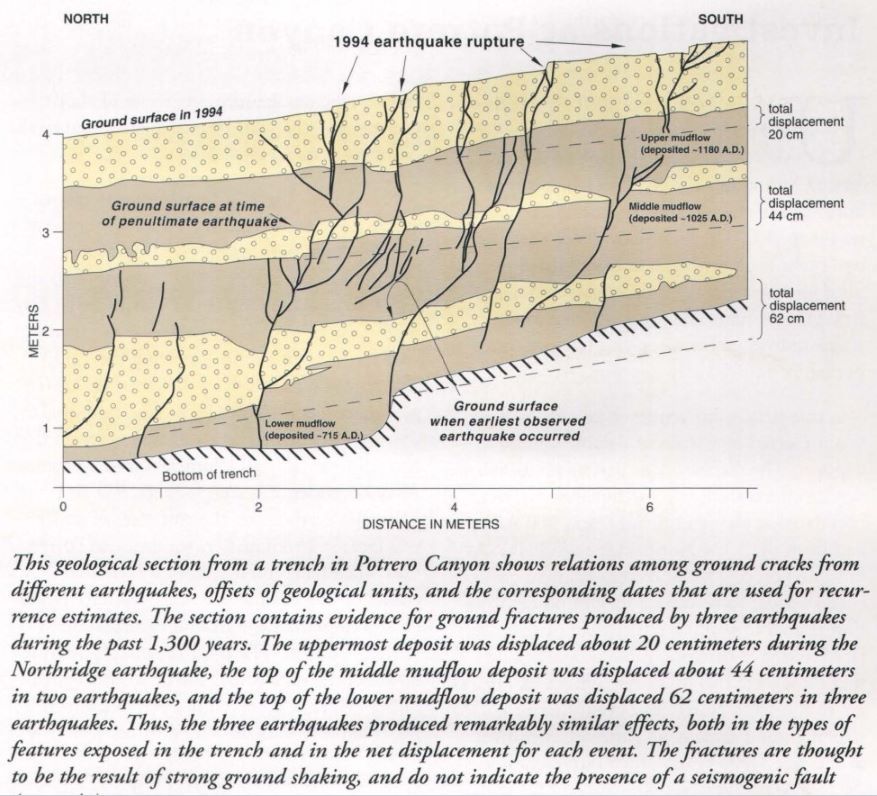
From OFR 96-263, 1996.
The June 1994 Stewart, Bray, Seed, & Sitar preliminary report concluded:
"that much of the observed ground breakage can be explained by dynamic compaction of the alluvial and colluvial deposits and large scale lateral spreading resulting from liquefaction of primarily sandy and silty sandy deposits. The lateral offsets along the margins are consistent with an overall movement of the valley deposits to the west, which is downslope."
Trenching showed that the (Rymer & Fumal, 1995, p.96):
"cracks occurred in Holocene alluvium, had up to 35 cm of vertical displacement (valley side down), and locally had a right-stepping pattern. Extensional cracks on the north side of the valley showed up to 45 cm of vertical displacement (valley side down) and a left-stepping pattern. Evidence from subsequent investigations suggest that the alluvium of Potrero Canyon settled significantly and laterally spread westward down valley."
For them, the shaking from the Northridge earthquake caused the earth to move and crack. There were no faults found in the trenches.
The US Geological Survey Open-File Report 97-283 (1997, p.15) reported that:
"The seismic velocity data and the seismic reflection images are suggestive of faults beneath Potrero Canyon that extend to the surface or near-surface. At depth, there appear to be at least two thrust faults that have little expression at the surface, suggesting they are blind thrusts."
So they say that although there may be faults underground, the faults don't seem to reach the surface. So only the shaking of the Northridgee quake caused the features found in the canyon.
The authors in the Bulletin of the Seismological Society of America (1998) concluded that:
"the strong shaking and some of the resulting surface cracks in Potrero Canyon may have resulted from co-seismic movement on faults in the Potrero Canyon area."
They hint that another fault could have caused the ground movement, but they couldn't prove it.
In conclusion, no study directly blamed a seismic fault for causing the ground movement in Potrero Canyon, although unmapped underground faults appeared to exist. "The fractures [and other features] are thought to be the result of strong ground shaking, and do not indicate the presence of a seismogenic fault." (OFR 96-263, 1996)









